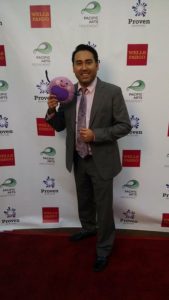
By Mandy Day
AsAmNews Correspondent
I was inspired to become a bone marrow donor in 2009 while attending a Japanese culture festival in Northern California. While there, thanks to the Diablo Valley Japanese American Citizen’s League, I learned about Nick Glasgow. He is a mixed race Japanese American suffering from cancer. Like me, Glasgow was a quarter Japanese. His grandfather was a serviceman stationed in Japan after the Second World War who fell in love with a Japanese woman, just like mine. Like my grandparents, they defied military regulations, and in some cases, state laws to remain together. One of the few things I knew about bone marrow donation at the time, was that mixed race patients mostly find mixed race donors. Glasgow found a donor. Unfortunately, it was not enough to save his life. He passed away a few months after the bone marrow drive.
Last fall, I watched a screening of Mixed Match, directed by Jeff Chiba Stearns and all the memories of that unseasonably warm day in July came flooding back. Many of the film’s subjects traveled to San Diego for the screening presented by Pacific Arts Movement including Athena Asklipiadis, founder of Mixed Marrow, a non-profit organization aiming to increase bone marrow donor participation among multi-ethnic people. “I tried to target more mixed race people to join the registry because I’m mixed race. I had met a patient named Krissy Kobata in Los Angeles and it wasn’t being talked about in the hapa clubs and mixed organizations I was a part of,” Asklipiadis told AsAmNews. According to Mixed Marrow’s website, only 4% of potential donors in 2015 identified as mixed race, or just shy of 500,000.

Mixed Match followed the stories of seven people and took six years to film. One woman had survived a marrow donation for more than a decade but suffered from the effects of graft-versus-host-disease. Another has been searching for nearly a decade for a donor and works with Asklipiadis to reach out to multi-ethnic communities and register donors. What is problematic with the registry, according to one specialist interviewed, nearly half of people are unwilling to donate or unable to be located when matched with a recipient. A patient finding a match doesn’t necessarily mean they’ll be getting a transplant.
The film succeeded in educating viewers about the science behind bone marrow. Caucasian patients are most likely to find matches and mixed race patients are among the least likely to match with a potential donor. The film explained the complexities of antigen typing and delved deep into the science behind matching bone marrow and cord blood for donation. As Asklipiadis found out when Be the Match (the world’s largest bone marrow registry) searched for her marrow matches, just a handful of people worldwide were potential donors for her should she need a transplant.
Stearns teamed up with Asklipiadis to raise awareness and seek answers as to why finding donors for mixed race patients was so difficult. He explained to AsAmNews that the film explores whether our genetics are becoming more rare as the mixed race population grows. Intertwined with the appropriately cute animated segments are stories of families affected by different blood diseases and cancers that leave them hoping for a marrow match to save a loved one.
The producers supplied all viewers with a packet of tissue, prior to the start of the film. I doubt anyone in there didn’t use them. Hunter Thawley’s family dedicates their life to enriching the lives of children through random acts of kindness. It was born from the loss of this little boy to Acute Myeloid Leukemia. Maya Chamberlin’s story was equally heart wrenching as viewers watched this young girl struggle with seizures caused by medication she was taking prior to her bone marrow transplant. Suffering from Hemophagocytic Lymphohistiocytosis, Maya met her donor at a dinner to raise funds for Asians for Miracle Marrow Matches (A3M).
Mixed Match didn’t just focus on people in need of matches. They also chronicled the journey of a donor, Alexandria Taylor. Watching a donor go through the process of bone marrow extraction made any reservations about being a donor disappear. Experts interviewed in the film believe that there is a misconception about how invasive and painful the procedure is. Taylor’s extraction left her with several needle marks on the back of her pelvic bone where the marrow was taken out. She described some soreness, but no lasting discomfort.
The documentary is an incredible example of the impact a few people can have in a community often overlooked. After watching it, I was a bit disappointed that I haven’t been matched with someone. For more information on bone marrow donation, you can find it at the following sites:
Mixed Marrow
AsAmNews is an all-volunteer effort of dedicated staff and interns. You can show your support by liking our Facebook page at www.facebook.com/asamnews, following us on Twitter, sharing our stories, interning or joining our staff.


RE: Mixed race Asians at risk: I became a donor a few years ago. Even though I am over 40, but because of my mixed and I mean mixed heritage I was able to do so. My family understands how hard it can be at times to get a proper diagnosis until we tell our doctors. Most doctors don’t think to ask they just assume people’s race.